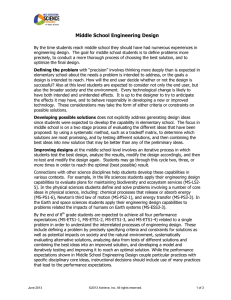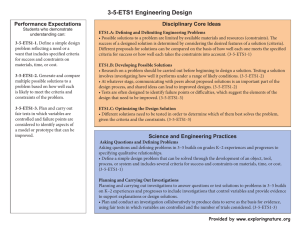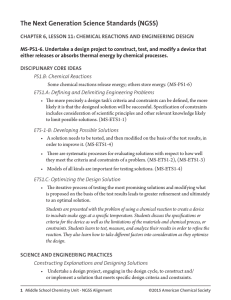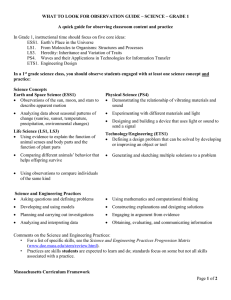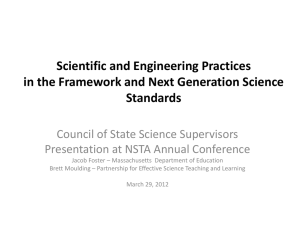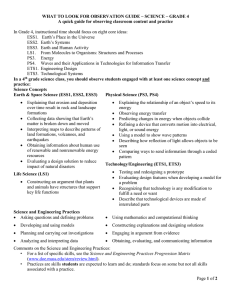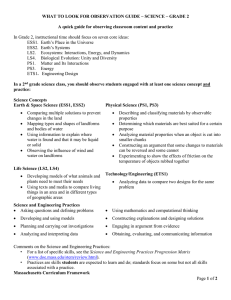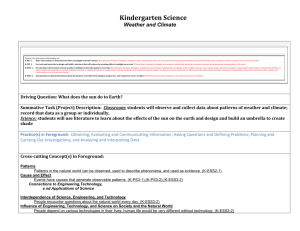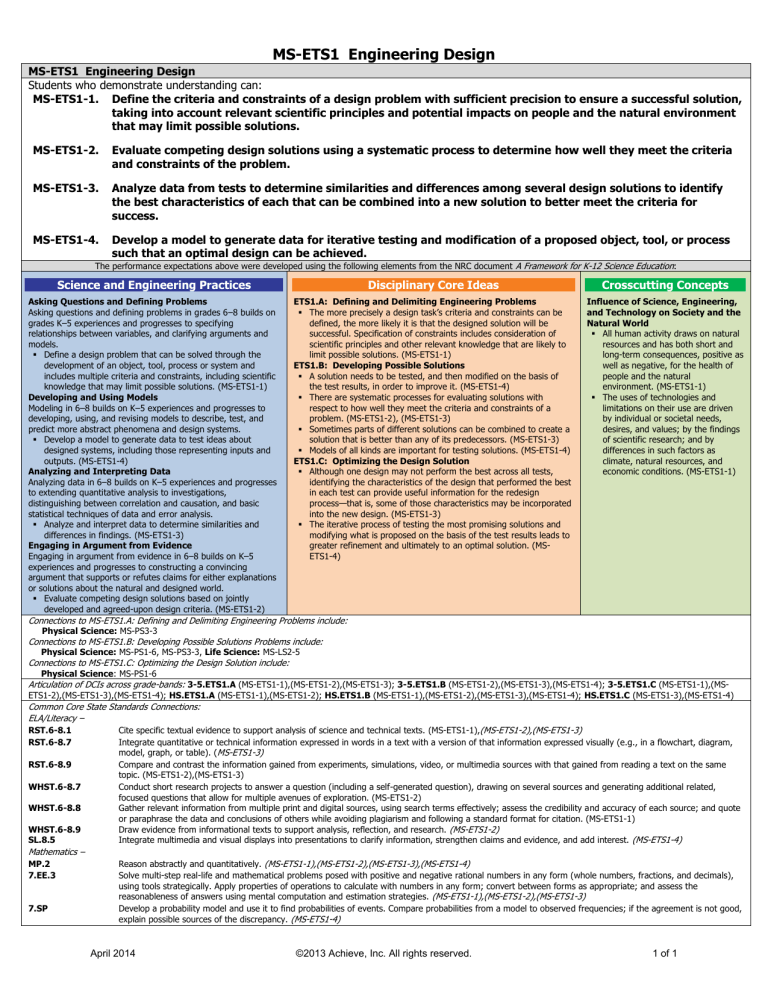
MS-ETS1 Engineering Design MS-ETS1 Engineering Design Students who demonstrate understanding can: MS-ETS1-1. Define the criteria and constraints of a design problem with sufficient precision to ensure a successful solution, taking into account relevant scientific principles and potential impacts on people and the natural environment that may limit possible solutions. MS-ETS1-2. Evaluate competing design solutions using a systematic process to determine how well they meet the criteria and constraints of the problem. MS-ETS1-3. Analyze data from tests to determine similarities and differences among several design solutions to identify the best characteristics of each that can be combined into a new solution to better meet the criteria for success. MS-ETS1-4. Develop a model to generate data for iterative testing and modification of a proposed object, tool, or process such that an optimal design can be achieved. The performance expectations above were developed using the following elements from the NRC document A Framework for K-12 Science Education: Science and Engineering Practices Disciplinary Core Ideas Crosscutting Concepts Asking Questions and Defining Problems Asking questions and defining problems in grades 6–8 builds on grades K–5 experiences and progresses to specifying relationships between variables, and clarifying arguments and models. Define a design problem that can be solved through the development of an object, tool, process or system and includes multiple criteria and constraints, including scientific knowledge that may limit possible solutions. (MS-ETS1-1) Developing and Using Models Modeling in 6–8 builds on K–5 experiences and progresses to developing, using, and revising models to describe, test, and predict more abstract phenomena and design systems. Develop a model to generate data to test ideas about designed systems, including those representing inputs and outputs. (MS-ETS1-4) Analyzing and Interpreting Data Analyzing data in 6–8 builds on K–5 experiences and progresses to extending quantitative analysis to investigations, distinguishing between correlation and causation, and basic statistical techniques of data and error analysis. Analyze and interpret data to determine similarities and differences in findings. (MS-ETS1-3) Engaging in Argument from Evidence Engaging in argument from evidence in 6–8 builds on K–5 experiences and progresses to constructing a convincing argument that supports or refutes claims for either explanations or solutions about the natural and designed world. Evaluate competing design solutions based on jointly developed and agreed-upon design criteria. (MS-ETS1-2) ETS1.A: Defining and Delimiting Engineering Problems The more precisely a design task’s criteria and constraints can be defined, the more likely it is that the designed solution will be successful. Specification of constraints includes consideration of scientific principles and other relevant knowledge that are likely to limit possible solutions. (MS-ETS1-1) ETS1.B: Developing Possible Solutions A solution needs to be tested, and then modified on the basis of the test results, in order to improve it. (MS-ETS1-4) There are systematic processes for evaluating solutions with respect to how well they meet the criteria and constraints of a problem. (MS-ETS1-2), (MS-ETS1-3) Sometimes parts of different solutions can be combined to create a solution that is better than any of its predecessors. (MS-ETS1-3) Models of all kinds are important for testing solutions. (MS-ETS1-4) ETS1.C: Optimizing the Design Solution Although one design may not perform the best across all tests, identifying the characteristics of the design that performed the best in each test can provide useful information for the redesign process—that is, some of those characteristics may be incorporated into the new design. (MS-ETS1-3) The iterative process of testing the most promising solutions and modifying what is proposed on the basis of the test results leads to greater refinement and ultimately to an optimal solution. (MSETS1-4) Influence of Science, Engineering, and Technology on Society and the Natural World All human activity draws on natural resources and has both short and long-term consequences, positive as well as negative, for the health of people and the natural environment. (MS-ETS1-1) The uses of technologies and limitations on their use are driven by individual or societal needs, desires, and values; by the findings of scientific research; and by differences in such factors as climate, natural resources, and economic conditions. (MS-ETS1-1) Connections to MS-ETS1.A: Defining and Delimiting Engineering Problems include: Physical Science: MS-PS3-3 Connections to MS-ETS1.B: Developing Possible Solutions Problems include: Physical Science: MS-PS1-6, MS-PS3-3, Life Science: MS-LS2-5 Connections to MS-ETS1.C: Optimizing the Design Solution include: Physical Science: MS-PS1-6 Articulation of DCIs across grade-bands: 3-5.ETS1.A (MS-ETS1-1),(MS-ETS1-2),(MS-ETS1-3); 3-5.ETS1.B (MS-ETS1-2),(MS-ETS1-3),(MS-ETS1-4); 3-5.ETS1.C (MS-ETS1-1),(MS- ETS1-2),(MS-ETS1-3),(MS-ETS1-4); HS.ETS1.A (MS-ETS1-1),(MS-ETS1-2); HS.ETS1.B (MS-ETS1-1),(MS-ETS1-2),(MS-ETS1-3),(MS-ETS1-4); HS.ETS1.C (MS-ETS1-3),(MS-ETS1-4) Common Core State Standards Connections: ELA/Literacy – RST.6-8.1 RST.6-8.7 RST.6-8.9 WHST.6-8.7 WHST.6-8.8 WHST.6-8.9 SL.8.5 Cite specific textual evidence to support analysis of science and technical texts. (MS-ETS1-1),(MS-ETS1-2),(MS-ETS1-3) Integrate quantitative or technical information expressed in words in a text with a version of that information expressed visually (e.g., in a flowchart, diagram, model, graph, or table). (MS-ETS1-3) Compare and contrast the information gained from experiments, simulations, video, or multimedia sources with that gained from reading a text on the same topic. (MS-ETS1-2),(MS-ETS1-3) Conduct short research projects to answer a question (including a self-generated question), drawing on several sources and generating additional related, focused questions that allow for multiple avenues of exploration. (MS-ETS1-2) Gather relevant information from multiple print and digital sources, using search terms effectively; assess the credibility and accuracy of each source; and quote or paraphrase the data and conclusions of others while avoiding plagiarism and following a standard format for citation. (MS-ETS1-1) Draw evidence from informational texts to support analysis, reflection, and research. (MS-ETS1-2) Integrate multimedia and visual displays into presentations to clarify information, strengthen claims and evidence, and add interest. (MS-ETS1-4) Mathematics – MP.2 7.EE.3 7.SP Reason abstractly and quantitatively. (MS-ETS1-1),(MS-ETS1-2),(MS-ETS1-3),(MS-ETS1-4) Solve multi-step real-life and mathematical problems posed with positive and negative rational numbers in any form (whole numbers, fractions, and decimals), using tools strategically. Apply properties of operations to calculate with numbers in any form; convert between forms as appropriate; and assess the reasonableness of answers using mental computation and estimation strategies. (MS-ETS1-1),(MS-ETS1-2),(MS-ETS1-3) Develop a probability model and use it to find probabilities of events. Compare probabilities from a model to observed frequencies; if the agreement is not good, explain possible sources of the discrepancy. (MS-ETS1-4) April 2014 ©2013 Achieve, Inc. All rights reserved. 1 of 1
